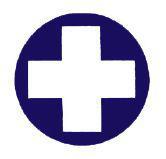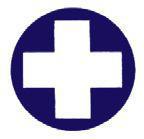SAS Urban Survival Handbook (123 page)
Read SAS Urban Survival Handbook Online
Authors: John Wiseman
Tags: #Health & Fitness, #Reference, #Survival, #Fiction, #Safety, #Self-Help, #Personal & Practical Guides, #General, #Survival Skills

SYMPTOMS
Nausea, vomiting, diarrhoea and stomach pain. Possibly shivering and fever. If infection is severe, there may be a risk of shock or unconsciousness.
ACTION
Mild cases of food poisoning can be treated at home. Give plenty of liquids, with a small amount of salt and sugar—but nothing to eat. Most cases clear within three days. If in any doubt, seek medical attention.
WARNING If diarrhoea/vomiting is especially severe, or if victim collapses or has difficulty in swallowing/speaking, seek urgent medical attention. Do not induce vomiting as a way of removing infected foodstuff. If the poisoning is severe, it is helpful to keep samples of the suspected meal or vomit for tests help pinpoint the cause. Other people may be at risk.
BACTERIAL POISONING
SALMONELLA
This name covers a group of bacteria. Commonly associated with raw chicken, eggs, raw meat and seafood. Symptoms usually develop within 24 hours. The young and elderly are particularly at risk. If a baby is affected, it may be vital to replace lost body fluids. Anyone who has had salmonella food poisoning should bear in mind that—for several months after the symptoms disappear—they may excrete the bacteria in their faeces. Consequently scrupulous hygiene should always be practised.
TYPHOID
Caused by one of the salmonella bacteria—
Salmonella typhi
. Associated with food or water contaminated by sewage. Alternatively flies or cockroaches may carry the bacteria to food. Shellfish exposed to sewage may be another risk. Any case of typhoid MUST always be reported to the local health authorities in industrialized societies—where the disease has become very rare (see
Tropical diseases).
LISTERIA
Listeria monocytogenes
is a very common bacterium. Humans may be exposed to it from salads, chilled food which is heated for eating, badly-cooked meat, soft cheeses. It can multiply in chilled food in a refrigerator if the temperature is not low enough—one important reason for observing sell-by and use-by dates. The infection—known as listeriosis—may be very serious and can kill very young children, the elderly and anyone with a depressed immune system. Pregnant women may be at risk.
STAPHYLOCOCCUS
Even proper cooking may not destroy toxins caused by various strains of ‘staph’. The most likely cause is from septic sores on the hands of the person preparing food. Symptoms usually occur within two to six hours.
BOTULISM
Rare, but associated with incorrect canning or preserving of food. The spores of the bacterium are resistant to cooking. Although rare in most developed countries, this is a very serious form of poisoning. Symptoms (apart from the symptoms mentioned earlier) usually develop within two days and include difficulty swallowing and disturbed vision. Early treatment is essential.
TROPICAL DISEASES
 Many diseases of tropical areas are linked to inadequate hygiene and geographical factors such as temperature and humidity. Malnutrition may contribute to the spread of disease, because it lowers the body’s ability to fight infection. Many of these diseases were once also common in temperate zones, but have been eliminated by improvements in public health and hygiene—in particular keeping water and soil free from contamination.
Many diseases of tropical areas are linked to inadequate hygiene and geographical factors such as temperature and humidity. Malnutrition may contribute to the spread of disease, because it lowers the body’s ability to fight infection. Many of these diseases were once also common in temperate zones, but have been eliminated by improvements in public health and hygiene—in particular keeping water and soil free from contamination.
It’s worth bearing in mind that many tropical diseases are very localized. Sleeping sickness, for example, an extremely serious parasitic disease spread by the tsetse fly, only occurs in areas of Africa. The malaria map of the world is constantly changing and, what’s more, mosquitoes can become resistant to the preventative drugs. That’s why you should always get your doctor to check the most up-to-date medical information for the region you intend to visit.
Vaccinations should be obtained before travel to tropical areas, but note that these only offer partial protection—other precautions, such as food and water hygiene, must also be observed scrupulously. Avoid uncooked food. Take insect-repellent sprays, a mosquito net to use at night and long-sleeved clothing and socks to protect exposed skin. For information on risk zones and special immunizations see IN TRANSIT.
CHOLERA
Infection of the small intestine, caused by food or water contaminated with the bacterium
Vibrio choleroe.
Cholera is prevalent in Africa, the Middle East and Far East. Cholera can only be controlled worldwide by improving sanitation and ensuring that contaminated water does not come into contact with drinking water. Major epidemics tend to follow natural disasters, especially in crowded conditions or if few people are left to nurse the sick.
SYMPTOMS
Profuse watery diarrhoea and vomiting. Can lead to dehydration.
ACTION
Seek urgent medical attention. If the diarrhoea is severe, the victim may dehydrate rapidly and die. Lost fluids should be replaced by plenty of liquid, to which has been added salt and sugar at one level teaspoon of salt/eight level teaspoons of sugar in one litre (about two pints) of water. Most patients make a full recovery, but some may need hospital treatment if dehydration continues despite fluid replacement.
PREVENTION
Travellers to risk areas should obtain a cholera vaccine (which usually lasts for six months). Boil all drinking water or buy it from reliable sources.
DENGUE
Viral disease spread by the mosquito
Aedes aegypti.
Southeast Asia, Africa, the Pacific region and South/Central America are all risk areas. Outbreaks known in Mexico, Puerto Rico and the US Virgin Islands.
SYMPTOMS
Rash, headaches, fever, extreme muscle and joint pains. These initial symptoms tend to subside after a couple of days, only to reoccur. It may take some weeks for a full recovery to be made, although serious complications are rare.
ACTION
There is no ‘cure’ for dengue and no vaccine. Painkillers may be needed to relieve the symptoms. Steps should be taken to avoid being bitten by mosquitoes in the first place—wear protective clothing (particularly at dawn/dusk) and use insect-repellent sprays and mosquito nets.
MALARIA
Serious disease spread by the bites of
Anopheles
mosquitoes. Malaria is a major health problem in the tropics. It affects 200 to 300 million people worldwide and kills over a million people every year in Africa alone.
SYMPTOMS
Symptoms usually appear within two weeks of being bitten, but may not appear for up to a year if the victim has taken antimalarial drugs inconsistently. Symptoms are fever with chills and shaking, with three stages. At first, the patient may be cold, with uncontrollable shivering. The temperature may then rise to 40.5° C (105° F). There may be profuse sweating, which helps bring the temperature down. All these symptoms may be accompanied by severe headaches, malaise and vomiting. After the fever attack the patient may be weak and exhausted.
ACTION
Seek urgent medical attention. This is an emergency and may require admission to hospital. Antimalarial drugs and, in severe cases, blood transfusions may be given.
PREVENTION
Antimalarial drugs should be taken by all visitors to the tropics, including pregnant women. Wear clothing that covers legs and arms in the evening. Insect repellent sprays and mosquito nets all reduce the likelihood of being bitten.
TYPHOID FEVER
Acute, highly-infectious disease affecting the digestive tract, caused by the bacterium
Salmonella typhi.
Paratyphoid is milder and caused by the bacterium
Salmonella paratyphi.
Both are contracted from contaminated food or drink, and are more common in hot climates than in temperate areas.
SYMPTOMS
Headache, aching limbs, fatigue, fever lasting several days, then subsiding and returning a few days later. Constipation and mental confusion accompany the fever. Later diarrhoea, bloating of the abdomen and red spots on chest and abdomen may occur.
ACTION
This is an emergency. Seek urgent medical attention as soon as salmonella poisoning is suspected. Treatment is likely to include antibiotics, rehydration and hospitalization—usually in isolation.
PREVENTION
Scrupulous hygiene in handling food. Avoid shellfish from possibly contaminated waters. Eggs, which have recently been identified as carrying the bacteria in some cases, improperly thawed frozen poultry and some ‘cook-chill’ foods must all be thoroughly cooked to destroy the bacteria. Immunization against typhoid and paratyphoid lasts several years.
TYPHUS
A group of infectious diseases caused by micro-organisms that are similar to bacteria (rickettsiae). Usually spread by insects such as fleas, mites and ticks.
SYMPTOMS
Headache, constipation, collapse, pain in the back and limbs and coughing Followed by fever, mild delirium and a rash of small red spots. There may also be a weak heartbeat.
ACTION
Seek urgent medical attention. Prompt treatment may help to avoid death from septicaemia (blood poisoning), heart failure, kidney failure or pneumonia. Part of the treatment may include antibiotic drugs. Convalescence is often slow, especially for elderly people.
PREVENTION
Insecticides to control louse infestation, vaccination and protective clothing may all discourage bites from tyhpus-carrying insects. Preventative measures are important in crowded tropical conditions and after a natural disaster.
YELLOW FEVER
Infectious disease transmitted in urban areas by
Aedes aegypti
mosquitoes. Some types may be spread from monkeys to humans. Yellow fever is prevalent in Africa, Central and South America.
SYMPTOMS
Nosebleeds, headaches, nausea and fever. Heartbeat may be slow, despite the fever. Recovery usually takes place within three days. In severe cases there may be pain in the back, neck and legs. Rapid liver damage may lead to yellowing of the skin (jaundice) and kidney failure. In untreated cases, these may be followed by mental disturbances or delusions, then coma and eventually death.
ACTION
There is no effective drug. Treatment involves maintaining the volume of blood in the body, often by transfusion. Most people recover before the disease progresses. Once you’ve had it you’re immune.
PREVENTION
Vaccination should be sought by travellers to risk areas, except for babies under a year old. A vaccination certificate is required for entry into or exit from some countries where the disease is prevalent.
PLAGUE
Plague killed 25 million people, in Europe alone, in the 14th century. Today it is responsible for up to 50 human deaths each year, mainly confined to parts of Africa, South America and Southeast Asia. Caused by the bacteria
Versina pestis
and spread by the bites of fleas that have lived on dead rats. There are two types—bubonic, characterized by swollen lymph glands or ‘buboes’, and pneumonic, which affects the lungs. Both must be treated IMMEDIATELY or will almost always prove fatal.
Travellers to high-risk areas should NEVER touch a rat or the carcass of any animal or bird. A vaccine is available for people in high-risk occupations.
STDs
 Sexually-transmitted diseases are infections spread primarily, in a majority of cases, by sexual intercourse, heterosexual or homosexual.
Sexually-transmitted diseases are infections spread primarily, in a majority of cases, by sexual intercourse, heterosexual or homosexual.
Confidential diagnosis and treatment is given at STD clinics, where a doctor will assess the infection or infections—usually prescribing a course of antibiotic drugs. Tests are usually made after the symptoms have gone, to ensure that the patient no longer has the infection.